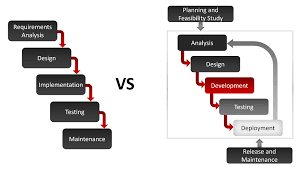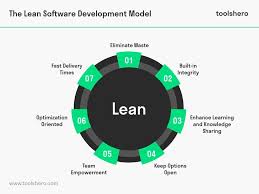The Agile Development Framework
Agile development is a software development methodology that emphasizes flexibility, collaboration, and continuous improvement. It is a framework that allows teams to respond to changes quickly and deliver high-quality software in a timely manner.
One of the key principles of agile development is the iterative approach to software development. Instead of planning the entire project upfront, agile teams break the project into smaller iterations or sprints. Each sprint typically lasts 1-4 weeks and results in a potentially shippable product increment.
Another important aspect of agile development is the close collaboration between team members and stakeholders. Daily stand-up meetings, regular retrospectives, and constant communication ensure that everyone is on the same page and working towards a common goal.
Continuous feedback is also a core principle of agile development. By regularly testing and reviewing the product with stakeholders, teams can quickly identify issues and make necessary adjustments. This allows for faster delivery of value to customers.
Overall, the agile development framework promotes adaptability, transparency, and customer satisfaction. By embracing change and focusing on delivering working software frequently, agile teams can stay ahead in today’s fast-paced business environment.
8 Essential Tips for Mastering Agile Development Frameworks
- 1. Embrace change and welcome it as a way to improve the project.
- 2. Prioritize collaboration and communication among team members.
- 3. Break down the project into smaller, manageable tasks or user stories.
- 4. Conduct regular meetings like daily stand-ups to keep everyone aligned.
- 5. Encourage self-organizing teams to make decisions collectively.
- 6. Continuously deliver working software in short iterations or sprints.
- 7. Gather feedback from stakeholders and end-users regularly for improvements.
- 8. Reflect on the team’s performance after each iteration to identify areas for enhancement.
1. Embrace change and welcome it as a way to improve the project.
In the agile development framework, it is crucial to embrace change and view it as an opportunity to enhance the project. By being open to modifications and welcoming new ideas, teams can adapt quickly to evolving requirements and market demands. Embracing change fosters innovation, encourages continuous improvement, and ultimately leads to the delivery of a more successful and customer-centric product.
2. Prioritize collaboration and communication among team members.
In the Agile Development Framework, prioritizing collaboration and communication among team members is crucial for success. By fostering a culture of open communication and teamwork, team members can share ideas, address challenges, and work together towards a common goal. Regular stand-up meetings, retrospectives, and other collaborative activities help ensure that everyone is aligned and working efficiently towards delivering high-quality software. Strong collaboration and communication not only improve team morale but also lead to better outcomes for the project as a whole.
3. Break down the project into smaller, manageable tasks or user stories.
In the agile development framework, a crucial tip is to break down the project into smaller, manageable tasks or user stories. By dividing the project into bite-sized chunks, teams can focus on delivering incremental value and progress. This approach not only helps in better planning and estimation but also allows for more flexibility and adaptability as priorities shift. Breaking down the project into smaller tasks ensures that each team member knows their responsibilities and can contribute effectively towards achieving the project goals.
4. Conduct regular meetings like daily stand-ups to keep everyone aligned.
Conducting regular meetings, such as daily stand-ups, is a crucial tip in the agile development framework to ensure that all team members are aligned and working towards common goals. These daily check-ins provide an opportunity for team members to communicate their progress, discuss any roadblocks they may be facing, and collaborate on solutions. By maintaining open communication and transparency through regular meetings, teams can stay focused, motivated, and ultimately deliver high-quality software efficiently.
5. Encourage self-organizing teams to make decisions collectively.
Encouraging self-organizing teams to make decisions collectively is a fundamental aspect of the agile development framework. By empowering team members to collaborate and take ownership of their work, organizations can foster a culture of trust, creativity, and innovation. This approach not only increases team morale and engagement but also leads to more effective problem-solving and decision-making processes. Ultimately, allowing teams to make decisions collectively promotes a sense of ownership and accountability that drives successful project outcomes in agile development.
6. Continuously deliver working software in short iterations or sprints.
In agile development framework, a crucial tip is to continuously deliver working software in short iterations or sprints. By breaking down the project into manageable chunks and focusing on delivering functional software at the end of each sprint, teams can quickly respond to feedback, adapt to changes, and ensure that the product meets the evolving needs of stakeholders. This iterative approach not only accelerates the delivery of value to customers but also promotes collaboration, transparency, and quality throughout the development process.
7. Gather feedback from stakeholders and end-users regularly for improvements.
Gathering feedback from stakeholders and end-users regularly is a crucial aspect of the agile development framework. By actively seeking input from those who will ultimately use the product, teams can identify areas for improvement and make necessary adjustments early on in the development process. This continuous feedback loop not only ensures that the product meets the needs and expectations of its users but also allows for quick iterations and enhancements based on real-world usage. Embracing feedback from stakeholders and end-users is key to delivering a successful and valuable product in an agile development environment.
8. Reflect on the team’s performance after each iteration to identify areas for enhancement.
After each iteration in the agile development framework, it is crucial to reflect on the team’s performance to pinpoint areas for improvement. By taking the time to assess what went well and what could have been done better, teams can enhance their processes and deliver even better results in the next iteration. This reflective practice fosters a culture of continuous improvement and helps teams adapt quickly to changing requirements, ultimately leading to more successful and efficient project outcomes.




